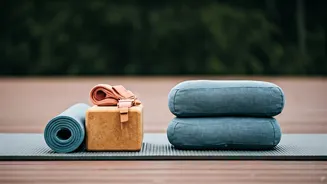Mindful Breathing's Power
Mindful breathing is a fundamental practice rooted in being present in the moment and paying attention to your breath without judgment. To begin, find
a comfortable posture, either seated or lying down. Close your eyes or gently soften your gaze. Bring your awareness to your breath, noticing the sensation of each inhale and exhale. Observe the rise and fall of your chest or abdomen. As your mind wanders (and it will!), gently redirect your focus back to your breath. There is no need to force or change your breath; simply observe it as it is. Practice this for a few minutes each day, gradually increasing the duration as you become more comfortable. This exercise helps to reduce racing thoughts, lower stress levels, and cultivates a greater sense of self-awareness. It's a key technique for centering yourself in the present moment.
Guided Imagery Practice
Guided imagery combines breath awareness with mental visualization to induce relaxation. Begin by finding a quiet space where you can be undisturbed. Settle into a comfortable position and close your eyes. Take a few deep breaths, focusing on the sensation of your breath. Then, visualize a peaceful scene – a serene beach, a tranquil forest, or any environment that brings you comfort. Engage all your senses. Imagine the warmth of the sun, the gentle breeze, the sounds of nature. As you breathe deeply, allow yourself to fully immerse in the visualization. If your mind wanders, gently bring your focus back to the image and your breath. Guided imagery is a powerful technique for reducing anxiety, promoting relaxation, and fostering a sense of inner peace, helping you to escape the stressors of everyday life by creating a relaxing environment in your mind.
Diaphragmatic Breathing
Diaphragmatic breathing, also known as belly breathing, is a technique that involves using your diaphragm, the primary muscle of respiration. To practice this, lie on your back or sit comfortably, placing one hand on your chest and the other on your abdomen. Inhale slowly and deeply through your nose, allowing your abdomen to rise while keeping your chest relatively still. Your hand on your abdomen should move, while the hand on your chest should remain still. Exhale slowly through your mouth, allowing your abdomen to fall. Repeat this process for several minutes, focusing on the movement of your diaphragm. This technique helps to increase oxygen intake, lower heart rate, and activate the parasympathetic nervous system, promoting relaxation and reducing stress. Consistent practice of diaphragmatic breathing strengthens your respiratory muscles and improves overall breathing efficiency.
Box Breathing Method
Box breathing, a simple yet effective technique, involves counting during each phase of your breath. Sit comfortably and close your eyes. Begin by inhaling slowly through your nose for a count of four. Then, hold your breath for a count of four. Next, exhale slowly through your mouth for a count of four. Finally, hold your breath again for a count of four. Repeat this cycle several times, focusing on the numbers and the rhythm of your breath. Box breathing is incredibly useful in managing anxiety and stress. The even counting helps to focus your mind, and the controlled breathing helps to regulate your nervous system. You can adjust the counts to fit your comfort level. The key is to maintain the same duration for each phase, creating a square pattern with your breath. It's a quick and portable way to find a sense of calm anytime, anywhere.
Alternate Nostril Breathing
Alternate nostril breathing, or Nadi Shodhana, is a yoga technique that is believed to balance the energy channels in the body. Sit comfortably, closing your eyes. Use your right thumb to gently close your right nostril. Inhale deeply through your left nostril. Then, close your left nostril with your ring finger, releasing your right nostril. Exhale slowly through your right nostril. Inhale through the right nostril, close it with your thumb, and exhale through your left nostril. Continue this pattern for several rounds. This practice helps to calm the mind, reduce stress, and improve focus. It can also help clear the nasal passages and promote a sense of overall well-being. It should be done gently, and with awareness, listening to your body's response.













